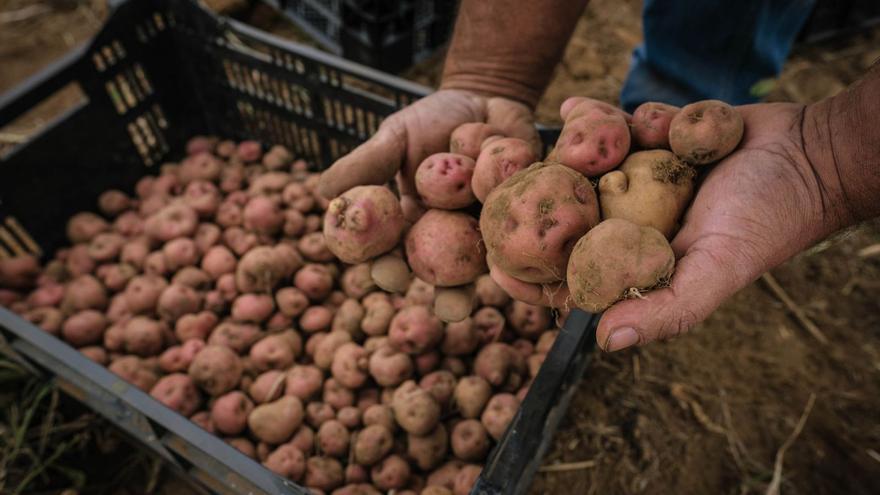
The northern orchards treasure unique products: onions from Guayonge, Masca or Carrizales; rambleros peaches, millo from El Tanque, plums from La Orotava, apples from the Valley or lentils from Teno.
Onions from Guayonge (Masca, Carrizal Alto and Carrizal Bajo), lentils from Teno, ramblero peaches, plums from La Orotava, millo villero and millo from El Tanque, bow tie apples from the Valley of La Orotava, sweet potatoes from Masca, culochico chestnuts from Santa Úrsula and La Victoria… orchards and farms in the north of Tenerife hide authentic culinary treasures and agricultural biodiversity. A wealth unknown to the vast majority of inhabitants and visitors to the island. A natural heritage preserved thanks to the efforts of generations of farmers who have kept unique seeds from unique places safe.
Their conservation is now guaranteed, even if they ended up being lost in the field, thanks to the scientific work of the Center for the Conservation of Agricultural Biodiversity of Tenerife (CCBAT). An entity, created in 2003, which depends on the Technical Service of Agriculture and Rural Development of the Cabildo de Tenerife and which preserves thousands of local seeds and plants in its facilities.
Many ancient varieties have been lost, but those that have been saved have done so thanks to the quiet and anonymous work of small farmers in isolated corners and forgotten for centuries. This is the case of the hamlets of Masca, Carrizal Alto and Carrizal Bajo, in Buenavista del Norte. Three small population centers where barely 116 people live. There, at least four singular varieties are conserved: onions from Masca and Carrizal Alto y Bajo, and the venturera sweet potato. Not far from there are the last lentil orchards in Teno.
“The one with the most future”
The Guayonge neighborhood, in Tacoronte, is home to the jewel in the crown of Tenerife varieties, with the permission of the beautiful potatoes. For the director of the CCBAT, Domingo Ríos, this is “one of the sweetest onions in the world.” It works commercially and many consider it a delicacy, which guarantees its conservation. «It could be the one with the most future, as long as the calendar is respected. They are spring-summer products and they cannot be removed from there,” warns Ríos. Onions from Masca and Los Carrizales also remain a sought after product, although on a smaller scale. The cultivation area “at least is maintained.”
in all Canary Islands There are some 167 different varieties of millet, among which are the El Tanque millet, with a notable variety of colors in the grain of the different pineapples, and the villero millet, very productive and therefore highly appreciated by farmers. Although it hybridizes easily and that complicates the maintenance of the original variety.
receding pulses
The cultivation of legumes is in clear decline, but the northwest of Tenerife still treasures varieties such as the aforementioned Teno lentil. Domingo Ríos indicates that “it is similar to that of Lanzarote and is still cultivated in Teno, in a not very extensive way, since it is necessary to pick it by hand.” Some restaurants in the area occasionally offer it on their menu.
The venturera sweet potato is typical of Masca and is not grown outside the Teno Rural Park. “It is white and exquisite,” warns Ríos, but it is only cultivated on a small scale.
The bow tie apple, which is recovering in the Valley of La Orotava, “is very good, but it has conservation problems, which complicates its commercial outlet. It is usually a garden edge crop that is used for family consumption. The ramblero peach, native to the coastal area of the municipality of San Juan de la Rambla, is another highly prized fruit that is kept in small farms with “no more than one hundred trees”. Most of the production is in La Rambla, Santa Catalina and Icod de los Vinos.
There are around 31 varieties of chestnuts in Tenerife, of which at least three are in the process of being registered. One of them is the chestnut culochico, common in Santa Úrsula and La Victoria de Acentejo. «95% of the chestnut growers on the island are between La Esperanza and Icod el Alto, in most cases with a certain degree of abandonment because they are crops on the edge of orchards, in many cases affected by property problems, daughters , etc.”, acknowledges Ríos. This expert focuses on a new threat to chestnuts in Tenerife: the wasp. An insect that for a year has been investigated for its negative effects on the chestnut trees on the west slope of the Valle de La Orotava, in the municipality of Los Realejos. Stopping the proliferation of this pest is a key objective for the future of the chestnut on the island.
The pretty potatoes
The first potatoes in Europe began to be cultivated continuously in Icod el Alto, in Los Realejos, more than four centuries ago. They arrived from the Andean zone of Peru and Bolivia, they acclimatized and evolved. The Protected Designation of Origin of Canary Islands Old Potatoes protects a total of 29 genetically unique potato varieties, of which at least 13 are regularly cultivated in this corner of northern Tenerife. It is about the white lily, the black lily, the white wig, the black wig, the red or pink wig, the pretty black, the pretty white, the pretty red, the pretty partridge eye, the red baga, the borralla or melonera, the red borarla or the terrenta. Delicacies that have suffered for years from the effects of the dreaded potato bug, the Tecia solanivora or Guatemalan moth, capable of destroying more than 50% of the crops.
The work of cataloging and conserving the seeds of bonita potatoes has been a success and “each year between 500 and 600 hectares are cultivated” that maintain these traditional products also on the plates of consumers, according to Ríos.
50 varieties of sweet potatoes
Throughout the island, the CCBAT has studied some 50 different local varieties of sweet potatoes, of which more than 20 are grown in the Anaga Rural Park, such as the Rajadilla de Anaga. There are also about 13 varieties of beans; five species of peppers, such as the bell pepper, the goat’s horn, the pigeon’s heart or the cat’s pinga; five of onions; six of garlic…
It is a delicious variety that in Tenerife also includes figs, wheat, almonds, plums, pears, millets, peas, peas, chochos, chickpeas, broad beans, full or round bubangos, wheel or violin pumpkins, cabbages or simply unique tomatoes.
















